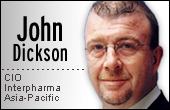IT sharpens Interpharma's edge

 |
John Dickson, CIO of Interpharma Asia-Pacific, says having IT applications and systems that meet the needs of the business has helped it differentiate itself from the competition. Interpharma Asia-Pacific is the parent company of the Zuellig Pharma distribution companies and the region's largest pharmaceutical sales, logistics and distribution company.
The Australian-born, who is currently based at the global head office in Hong Kong, is no stranger to Asia. Dickson has been working in Asia for the past 15 years, and his wealth of IT experience over the past 20 years extends across several industries, including banking, fast moving consumer goods, and pharmaceutical distribution.
In an exclusive phone interview with ZDNet Asia, Dickson talks about the role of IT within the company and shares the hot-button areas that have caught his attention.
Q: What role does IT play in Interpharma's overall management strategy?
Dickson: Depending on the country, we are in some instances the biggest distributor of pharmaceuticals, and certainly the leading and biggest pharmaceutical distributor across Asia, by almost any measure. To my knowledge, nobody else is [as] big.
Name |
IT is key to Interpharma. [This is because] Zuellig Pharma is very dependent on IT [as] all of our [pharmaceutical sales] orders come through the computer systems that manage the warehouses. We have the AsiaRx ordering system, which is an online ordering system that customers use, [as well as] a system we call the ZIPonline or Zuellig Information for Principals--'principals' being manufacturers. ZIPonline has all the sales and distribution information in it, and a lot of principals are very dependent on that. It's really a data warehouse, a business intelligence tool.
Would you say then that IT is the backbone of the company?
The company is certainly very dependent on IT, whether it's the backbone or not. The backbone of the company is our sales, our distribution knowledge, and our logistics ability, that's supported by IT.
The company's distribution [channels are] very dependent on IT, and all orders that come in go immediately into the sales system of the respective country. Nothing is done manually. Regardless of how the order comes in--by fax across the AsiaRx, the Internet or through the phone, none of them will be acted on until they're in the computer system. The sales system in the country then generates the order and triggers the picking activities in the warehouse.
What are the main functions of IT?
Our primary function is [to support the distribution of] pharmaceuticals, providing information back to the manufacturers, also known as the principals, and thereafter receiving orders from customers. Our customers are the people who consume pharmaceuticals, such as hospitals, governments, chemist chains, pharmaceutical shops, doctors, and wholesalers. The type of customer depends on the country as they're different in different countries.
Does IT take a priority in the company's management strategy?
IT has a very high priority. We view IT, and a few key systems that we have, as key strategic differentiators from our competition.
What are Interpharma's key IT focus areas now?
One of the things is getting our outsourcing project completed and getting us maximum benefit out of that. We've recently been outsourcing our corporate systems via HDS (Hitachi Data Systems) to outsourcing companies, and ultimately, the [outsourced work] resides with Atos Origin and Kaz Computer Services.
Other key things are some enhancements of the sales order entry systems in each country. We're also looking at rolling out a portal to combine our many systems across the different countries in Asia. [In addition], a lot of our focus is in the business intelligence area. Business Intelligence is a bit of a hot subject for us. We [also] have quite a bit of focus on process improvement and optimization.
What IT functions do you keep in-house or outsource?
The physical environment are predominantly outsourced. However, the applications for the corporate systems, as well as the customer-facing and the principal-facing systems, are [done] in-house.
I don't have a problem with outsourcing the physical environment, but AsiaRx and ZIPonline are totally proprietary to our company. It is unlikely that we will allow the writing of those applications to be done outside the company. Certainly, it is unlikely that the definition of requirements and the business analysis type of area will be outsourced.
How big is the IT team that serves the entire Asia-Pacific region?
There's an IT team in Manila comprising about 60 permanent staff and about 70 contract staff who works for all of Asia. Plus, there is also an IT team in every company and in every country that we have. The size of the team depends on the size of the country, ranging between four and 30 people.
What is Interpharma's business strategy in IT?
There's strong acknowledgment in the company that the IT strategy is inextricably linked to the business strategy, which is quite refreshing. There's no question within the company that IT is strategic, rather than tactical, and that is a differentiator for us.
To what extent would you attribute the company's success to IT?
We have for a long time, and still are, focused on building awareness of our leadership in IT and using it as a differentiator. Certainly our competitors have tried to offer something competitive, but none has had any impact at all. So, I'd like to think that what we offer is very strong and very competitive, and that it contributes a lot to the business and to the image of the business. For instance, it is not uncommon for us to get contracts from principals based on our IT [competencies].
Don't your competitors have a similar advantage?
They have systems that don't seem to be up to the level of acceptance or maturity compared to ours, in terms of mapping against the needs of our principals. According to the principals, our offerings seem to align more closely with their needs than the offerings of our competitors.
How would you rank Interpharma in terms of its maturity in IT adoption?
We're certainly very mature in knowing and understanding that we must have very competent and very robust IT systems, and there's no question about that. It would be fair to say that we are selective in our adoption of new technologies, but that's not the same as conservative. We're not conservative, but selective and very focused. We do put quite a lot of effort into understanding what will give us the most bang for the buck.
What's top on your agenda these days?
One, is finishing off outsourcing. Two, is the whole subject of business intelligence, such as what does it really mean and what is applicable.
Whilst [business intelligence is] such a fabulous buzzword, trying to pin it down is a bit of a slippery animal. It can be almost anything it wants to be or anything what we want it to be. But making it relevant to the needs of the people--the potential recipients, is not quite simple. It's not quite as simple a subject as just defining the application. It's a very broad subject, and it can be anything to anybody, which can be a problem.
Other areas include ways to cut our operational costs through the use of systems, which we're certainly looking at very closely now. SOA (service-oriented architecture) will also be a hot subject.